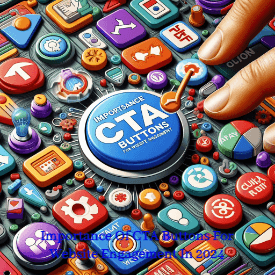In the vast and ever-expanding expanse of the internet, where countless websites clamor for attention in an endless sea of digital noise, the Importance Of CTA Buttons For Website Engagement stands out as a guiding light amidst the chaos.
Amid the multitude of design elements and content strategies, these seemingly innocuous buttons emerge as pivotal tools, capable of wielding immense influence in directing user behavior and catalyzing meaningful interactions and conversions.
As we explore the digital landscape, we peel back the layers to unravel the intricate workings of CTA buttons, shedding light on their significance and unveiling their indispensable role in capturing attention and actively fostering engagement and driving tangible results in the dynamic realm of online interaction.
Understanding The Importance Of CTA Buttons For Website Engagement
CTA buttons are not mere pixels on a screen but digital ambassadors of user engagement. These small yet mighty elements serve as the gateway to deeper interactions, beckoning visitors to take action and participate actively in the website’s offerings.
At their essence, CTA buttons encapsulate user intent, providing a clear and concise pathway for users to navigate the digital landscape.
When we delve deeper into the realm of CTA buttons, we uncover a tapestry of strategies and techniques aimed at maximizing their effectiveness. From the choice of language to the placement on the webpage, every aspect of CTA buttons is meticulously crafted to resonate with the target audience.
Whether it’s a persuasive “Download Now” button enticing users to access valuable content or a reassuring “Contact Us” button inviting visitors to initiate a conversation, CTAs are designed to elicit specific responses from users.
Moreover, CTA buttons serve as touchpoints in the user journey, guiding visitors along predefined paths toward desired outcomes. They act as beacons of direction, steering users towards conversions, subscriptions, purchases, or other valuable actions.

Strategically Placing CTAs At Critical Junctures
By strategically placing CTAs at critical junctures in the user flow, website owners can influence user behavior and drive desired actions effectively.
Understanding CTA buttons entails grasping their multifaceted nature and recognizing their pivotal role in shaping user engagement.
From their persuasive power to their strategic placement, CTAs are the linchpins of effective website design, facilitating seamless interactions and fostering meaningful connections between users and digital platforms.
CTA buttons are not mere pixels on a screen but digital ambassadors of user engagement. These small yet mighty elements serve as the gateway to deeper interactions, beckoning visitors to take action and participate actively in the website’s offerings.
At their essence, CTA buttons encapsulate user intent, providing a clear and concise pathway for users to navigate the digital landscape.
When we delve deeper into the realm of CTA buttons, we uncover a tapestry of strategies and techniques aimed at maximizing their effectiveness. From the choice of language to the placement on the webpage, every aspect of CTA buttons is meticulously crafted to resonate with the target audience.
Whether it’s a persuasive “Download Now” button enticing users to access valuable content or a reassuring “Contact Us” button inviting visitors to initiate a conversation, CTAs are designed to elicit specific responses from users.
Moreover, CTA buttons serve as touchpoints in the user journey, guiding visitors along predefined paths toward desired outcomes. They act as beacons of direction, steering users towards conversions, subscriptions, purchases, or other valuable actions.
Website owners can effectively influence user behavior and drive desired actions by strategically placing CTAs at key junctures in the user flow.
Understanding CTA buttons entails grasping their multifaceted nature and recognizing their pivotal role in shaping user engagement.
From their persuasive power to their strategic placement, CTAs are the linchpins of effective website design, facilitating seamless interactions and fostering meaningful connections between users and digital platforms.
Encouraging action at their core, CTAs are masterful persuaders, leveraging psychological principles to motivate users to take action. Through compelling language, a sense of urgency, and enticing offers, CTAs transform passive browsing into purposeful engagement.
They capitalize on the innate human desire for gratification, compelling users to click, subscribe, or purchase with irresistible allure.
Enhancing User Experience
Beyond their persuasive prowess, CTAs serve as guardians of user experience. In an era of distractions, CTAs provide clarity amidst the chaos, guiding users along the desired path with precision and finesse. Clear, conspicuous, and intuitive, they streamline navigation, eliminate friction, and elevate the overall user journey, ensuring seamless interactions across devices and platforms.
Designing Effective CTA Buttons
Crafting practical CTA buttons is akin to sculpting a masterpiece in the digital realm. Creating buttons that catch the eye and compel action requires a delicate balance of artistry, psychology, and technical prowess. At the heart of effective CTA design lies a deep understanding of user behavior and a keen eye for aesthetics and usability.
A/B Testing for Optimization: A/B testing emerges as the cornerstone of CTA button design, allowing website owners to experiment with variations and determine the most effective combination. Through iterative testing, subtle tweaks in design elements such as color, size, shape, and text can significantly improve click-through rates and conversion metrics.
Website owners can ensure that their buttons resonate harmoniously with their target audience by continuously refining and optimizing CTAs based on real-time data and user feedback.
Visual Appeal and Brand Consistency: Visual appeal is crucial in capturing users’ attention and enticing them to engage with CTA buttons. Every visual element, from vibrant colors to eye-catching graphics, should be carefully curated to create a cohesive and aesthetically pleasing design.
Moreover, it is essential to maintain brand consistency across all CTAs, ensuring that they align with the overall brand identity and messaging. By incorporating brand colors, fonts, and imagery, CTAs can evoke a sense of familiarity and trust, enhancing their effectiveness.
Clarity is paramount in CTA design; Users should understand the purpose of a CTA at a glance without any ambiguity or confusion. Clear and concise language, coupled with intuitive design elements, can help users quickly identify the action they are expected to take.
Additionally, it is essential to prioritize simplicity in CTA design, avoiding clutter and unnecessary distractions that may detract from the user experience.
Mobile Optimization: With the proliferation of mobile devices, optimizing CTAs for mobile users has become imperative. Mobile-optimized CTAs should be responsive, ensuring seamless functionality across various screen sizes and resolutions. Moreover, CTAs should be positioned strategically within the mobile interface, considering thumb reach and user behavior patterns.
By prioritizing mobile optimization, website owners can ensure that their CTAs remain effective regardless of the user’s device.
Designing practical CTA buttons requires a holistic approach that balances aesthetics, usability, and functionality. By leveraging A/B testing, prioritizing visual appeal and brand consistency, emphasizing clarity and conciseness, and optimizing for mobile, website owners can create CTAs that capture attention and drive meaningful engagement and conversions.

Overcoming Common Challenges
Despite their significance in driving website engagement, Call-to-Action (CTA) buttons are not immune to challenges that can hinder their effectiveness. From banner blindness to CTA fatigue, navigating these obstacles requires a strategic approach and a commitment to continuous improvement.
Addressing Banner Blindness: In today’s digital landscape, users are inundated with advertisements and promotional content, leading to a phenomenon known as banner blindness. This occurs when users unconsciously ignore or overlook CTAs and other promotional elements, diminishing their impact.
To overcome banner blindness, website owners must focus on creating CTAs that blend seamlessly with the overall design and user experience. Avoiding overly intrusive or aggressive tactics and instead integrating CTAs organically into the content can help them stand out without being disruptive.
Combatting CTA Fatigue: Optimizing CTAs for mobile users has become imperative with the proliferation of mobile devices. As users interact with websites over time, they may become desensitized to repetitive or stale CTAs, leading to CTA fatigue. This phenomenon can decrease engagement and conversion rates as users grow weary of the same prompts.
To combat CTA fatigue, website owners should regularly refresh and update their CTAs to keep them relevant and engaging. Experimenting with different messaging, visuals, and placement can help bring new life into CTAs and effectively capture users’ attention.
Keeping CTAs Fresh and Relevant: What works today may not work tomorrow in an ever-evolving digital landscape. Website owners must adapt their CTAs to remain relevant and effective as user preferences and behaviors change.
One strategy for keeping CTAs fresh is to stay informed about industry trends and emerging best practices. By staying ahead of the curve and experimenting with innovative approaches, website owners can ensure that their CTAs continue to resonate with their target audience.
Leveraging Personalization and Targeting: Another effective strategy for overcoming common CTA challenges is leveraging personalization and targeting. Website owners can increase their relevance and effectiveness by tailoring CTAs to specific audience segments based on demographics, interests, or past behavior.
Personalized CTAs can be dynamically generated based on a user’s location, browsing history, or purchase preferences. This approach enhances the user experience and improves engagement and conversion rates by delivering more targeted and compelling messaging.
Video
Importance Of CTA Buttons For Website Engagement: Conclusion
In the dynamic world of digital marketing and website design, the significance of Call-to-Action (CTA) buttons for website engagement cannot be overstated. These unassuming elements serve as the linchpins of user interaction, guiding visitors to conversion and fostering meaningful connections between users and digital platforms.
Throughout this exploration, we’ve uncovered the multifaceted nature of CTA buttons and their profound impact on user behavior. From their persuasive power to their strategic placement, CTAs are pivotal in shaping the user experience and driving desired actions.
By understanding the psychology behind effective CTAs, embracing best practices in design and optimization, and continuously refining strategies through testing and analysis, website owners can unlock the full potential of these small yet mighty elements.
As we navigate the ever-evolving landscape of online engagement, let us heed the call of the CTA, harnessing its power to forge deeper connections, inspire action, and chart the course toward digital success. In the hands of adept marketers and website owners, CTAs transcend mere buttons, becoming catalysts for meaningful engagement and driving tangible results.
Have you encountered particularly effective CTAs that compelled you to take action? Or perhaps you’ve experienced frustrations with poorly executed buttons that left you feeling disengaged? Share your insights, questions, and success stories in the comments below.
Your input enriches our understanding of CTA best practices and fosters a community of knowledge-sharing and collaboration. Let’s continue the conversation and empower one another to create compelling user experiences that drive results.
I look forward to reading your comments and engaging in meaningful discussions together!
Resource: For a deeper dive into user experience design, explore this comprehensive guide on UX design
Earl
